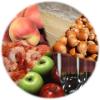CYBERMED LIFE - ORGANIC & NATURAL LIVING
CYBERMED LIFE - ORGANIC & NATURAL LIVING
 Allergen Free Diet : An allergen is a type of antigen that produces an abnormally vigorous immune response in which the immune system fights off a perceived threat that would otherwise be harmless to the body. Such reactions are called allergies.
Allergen Free Diet : An allergen is a type of antigen that produces an abnormally vigorous immune response in which the immune system fights off a perceived threat that would otherwise be harmless to the body. Such reactions are called allergies.
In technical terms, an allergen is an antigen capable of stimulating a type-I hypersensitivity reaction in atopic individuals through Immunoglobulin E (IgE) responses. Most humans mount significant Immunoglobulin E responses only as a defense against parasitic infections. However, some individuals may respond to many common environmental antigens. This hereditary predisposition is called atopy. In atopic individuals, non-parasitic antigens stimulate inappropriate IgE production, leading to type I hypersensitivity.
Sensitivities vary widely from one person (or other animal) to another. A very broad range of substances can be allergens to sensitive individuals.
Allergen Free Diet or an elimination diet, also known as exclusion diet and oligoantigenic diet, is a method of identifying foods that an individual cannot consume without adverse effects. Adverse effects may be due to food allergy, food intolerance, other physiological mechanisms (such as metabolic or toxins), or a combination of these. Elimination diets typically involve entirely removing a suspected food from the diet for a period of time from two weeks to two months, and waiting to determine whether symptoms resolve during that time period. In rare cases, a health professional may wish to use an oligoantigenic diet to relieve a patient of symptoms they are experiencing.
Common reasons for undertaking an elimination diet include suspected food allergies and suspected food intolerances. An elimination diet might remove one or more common foods, such as eggs or milk, or it might remove one or more minor or non-nutritive substances, such as artificial food colorings.
An elimination diet relies on trial and error to identify specific allergies and intolerances. Typically, if symptoms resolve after the removal of a food from the diet, then the food is reintroduced to see whether the symptoms reappear. This challenge-dechallenge-rechallenge approach has been claimed to be particularly useful in cases[clarification needed] with intermittent or vague symptoms.[medical citation needed]
The exclusion diet can be a diagnostic tool or method used temporarily to determine whether a patient’s symptoms are food-related. The term elimination diet is also used to describe a "treatment diet", which eliminates certain foods for a patient.
Adverse reactions to food can be due to several mechanisms. Correct identification of the type of reaction in an individual is important, as different approaches to management may be required. The area of food allergies and intolerances has been controversial and is currently a topic that is heavily researched. It has been characterised in the past by lack of universal acceptance of definitions, diagnosis and treatment.